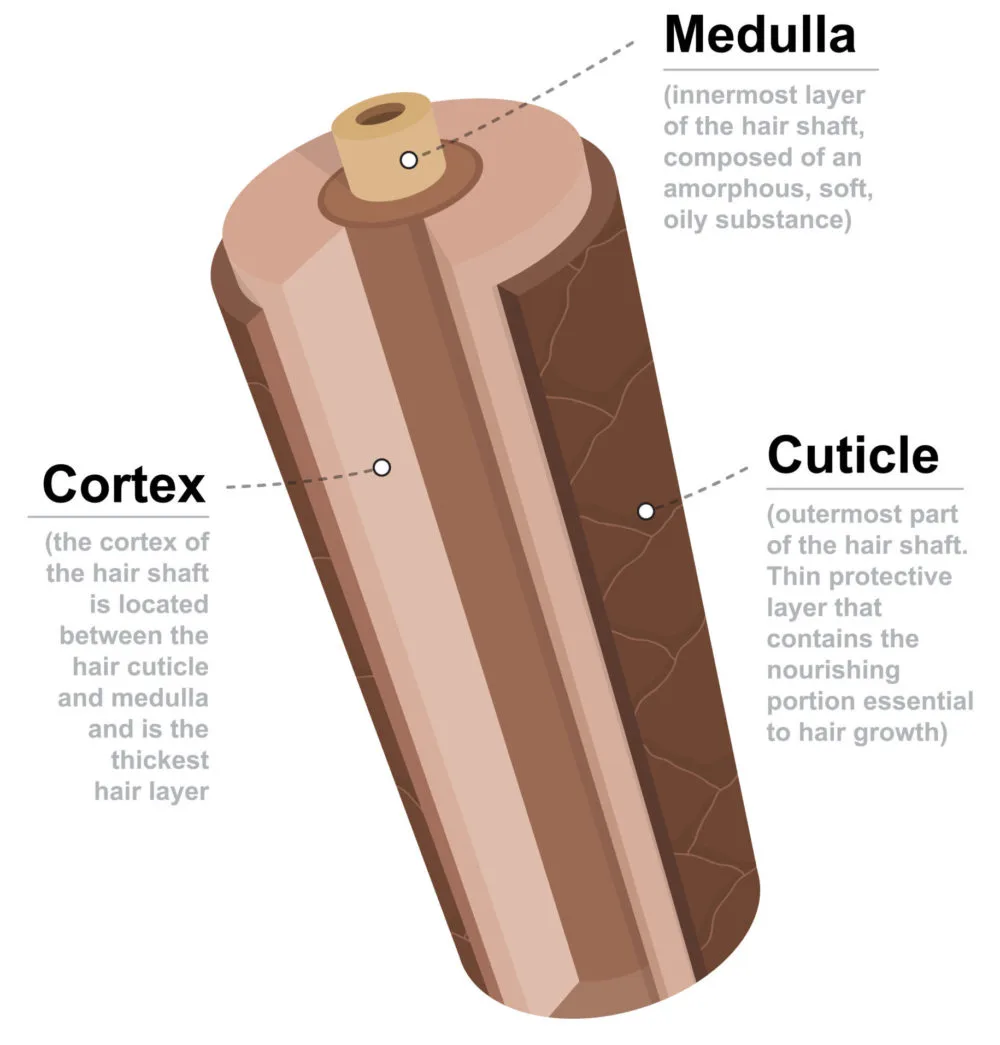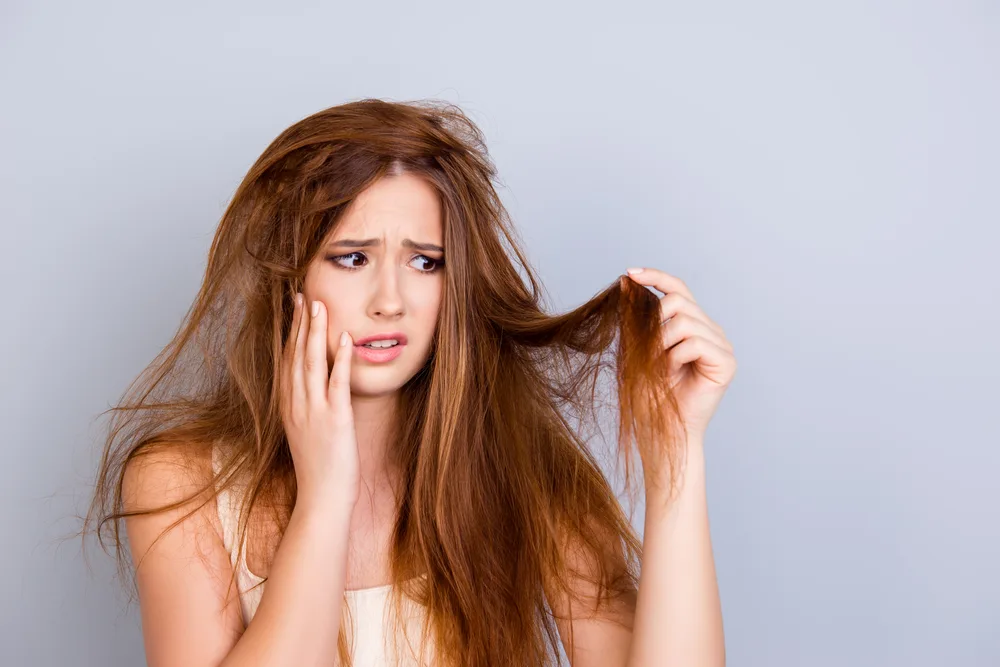Jump to:
Toner can correct the color of your hair after using a permanent dye or applying bleach. While toner is a great way to neutralize unwanted undertones, you might notice that your hair looks dry and brittle after going through this process.
Does toner damage hair? Let’s take a closer look at how these products work.
Does Toner Damage Hair?
Toner doesn’t contain the same level of ammonia as bleach or permanent hair dye. However, toner can still cause some degree of damage and worsen the dryness caused by bleaching or coloring your hair.
And this fun fact is actually very important; hair coloring products are becoming increasingly popular. There are more colors than ever available, and people are coloring their hair more frequently.
In fact, 31% of Americans used hair dye four to five times in 2020. The downside of these products is that they contain ammonia. Ammonia plays an important role in the bleaching or coloring process since it allows chemicals and pigments to penetrate hair strands.
However, it also causes damage in this process. Toner is typically less harmful than permanent dyes or bleach since it contains lower concentrations of ammonia but using a toner can still dehydrate your hair and cause damage.
Here’s what we’ll discuss in the article below:
- How toner works on hair
- How ammonia can cause damage to your hair
- Why toner is unlikely to be the main culprit behind hair damage
- How to prevent damage when applying toner
What Is Toner?
Hair toner is a product that you typically apply after bleaching or dyeing your hair. Its purpose is to adjust the undertones of your hair to achieve a specific color. Toner can enhance cool tones or remove unwanted yellow or brassy tones you usually get after bleaching.
How Does Toner Work?
You can think of toner as a mild hair dye. Pigmentation can vary from one product to another, with toners used by professionals having a higher concentration.
If you’re familiar with color theory, you know that opposite hues on the color wheel neutralize each other. When correcting your hair color, toner allows you to introduce a hue that will neutralize unwanted tones.
For instance, a purple toner is a popular option because it neutralizes the yellow tones you often get after bleaching. For those with darker hair, these unwanted tones can look orange or brassy. A blue toner can neutralize these tones.
Can Toner Damage Hair?
The answer is yes. Even though toners contain less ammonia compared to bleach and hair dyes, toners still contain some ammonia, unless you’re using an ammonia-free product. Ammonia plays a crucial role in the bleaching and dyeing process.
This chemical can lift the cuticles of your hair and allow the bleach to dissolve melatonin cells or permanent pigments to bond with the hair strand.
The downside is that ammonia leaves the hair follicles damaged. It can result in hair that feels dry and brittle. While tone can damage hair, the effects will vary depending on the product and application method you use.
Why Toner Won’t Usually Damage Hair

Paper Teo/Shutterstock
In most cases, you’ll use a toner after bleaching or dyeing your hair. Let’s take a closer look at the structure of human hair to understand how this process can damage your hair.
Fibrous proteins make up 65 to 95% of the hair structure. As the hair shaft grows out of the shaft, the follicle forms around it. The follicle has three layers, including the cuticle, cortex, and medulla.
The cuticle is the outer layer that protects the hair and guides its growth. The middle layer, the cortex, is where you’ll find hair pigment cells as well as keratin cells.
Keratin cells play a crucial role in making your hair look smooth and glossy. When you bleach your hair or apply a dyeing product that contains ammonia, the ammonia opens up the cuticle. It penetrates the cortex where it dissolves melanin to strip hair of its natural color.
In the case of permanent hair dyes, pigments will penetrate the cortex and bond with the hair cells. You can close the cuticle by applying a conditioner after this process.
But, regardless, some damage will always occur when you apply ammonia-based products to your hair. By contrast, toner causes less damage since it contains lower levels of ammonia.
However, applying toner after bleaching or dyeing your hair can worsen the damage caused by these products. Plus, repeated toner applications to adjust your hair color incrementally can worsen the damage and result in hair that looks brittle and dry.
How to Avoid Damage When Using a Toner
There are steps you can take to minimize damage when using a toner.
1. Choose an Ammonia-Free Toner
Not all toners contain ammonia. An ammonia-free toner will cause minimal damage to your hair. The downside is that it might not work as well as a product that contains ammonia.
If you need to correct your hair color and can see signs of damage after bleaching and dyeing, try applying an ammonia-free toner first.
2. Use Conditioner
Conditioner is the best way to repair damaged hair after a color change. You need to hydrate your hair to repair the cuticle after applying ammonia to your hair.
Using a deep conditioner that will form a protecting coating over your hair should improve its appearance. You can also hydrate your hair with a hair mask. A keratin treatment can also make a difference if you’re dealing with frizzy and brittle hair.
3. Avoid Dyeing Your Hair Too Often
The best thing to do after dyeing your hair is often to wait and let the damage heal. If you bleach or dye your hair too often, your cuticles won’t have enough time to return to normal.
4. Shampoo Less Often
Shampooing can strip hair from its natural oils and worsen dryness and brittleness. Try washing your hair less often or using a dry shampoo to avoid removing natural oils. Not sure how often to use shampoo? Take our simple “how often should I wash my hair” quiz!
Frequently Asked Questions

Roman Samborskyi/Shutterstock
Read on to learn more about using toner and preventing hair damage.
Can You Use Homemade Toners?
If you look for DIY toner ideas online, you’ll find articles and videos that recommend mixing conditioner with food dyes or diluting hair dye with conditioner. You should know that food dyes will only have a temporary effect.
Mixing conditioner and permanent hair dye will work, but it can be challenging to find the correct proportions. You might end up altering your hair color instead of correcting the undertones.
How Should I Put Toner in My Hair?
You’ll get better results if you apply toner to damp hair. You should use an applicator brush to coat your hair with the product. You can cover your entire hair with toner, but you can also focus on the roots or areas where you want to adjust your hair color.
What Is the Best Toner for Damaged Hair?
Try using an ammonia-free toner or look for a product that contains hydrating ingredients. If your hair looks brittle and damaged, you can use a hair mask or a deep conditioner to hydrate it before applying toner.
So, Does Toner Damage Your Hair?
So, does toner damage your hair? The answer is yes, a toner can cause damage to your hair. However, most of the damage you’ll see will likely come from the products you used before applying toner, including bleach and permanent hair dye.
If you want to change your hair color, remember to use a conditioner or a hair mask to hydrate your hair and repair some of the damage. Happy coloring!
